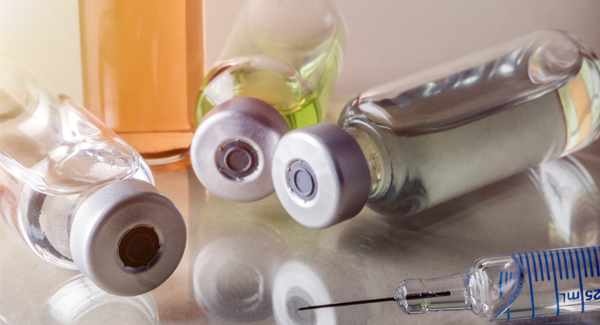Joint Injections for Arthritis Pain
Learn about different types of injections used to manage arthritis pain and symptoms.
A complete plan for managing your arthritis will include an array of therapies and treatments. They may include self-care measures like diet, exercise and heat/cold therapies; physical therapy; oral medicines; topical medicines; and even some injectable treatments. Here we’ll review some of the medicines and other compounds that may be injected directly into your arthritis-affected joints as well as a needle procedure used to draw fluid out of the joint.
Corticosteroids
What it is: A combination of a corticosteroid (or "steroid"), like cortisone, and a numbing agent is injected directly into the joint affected by arthritis. These shots are given in the doctor's office and usually are covered by medical insurance.
Benefits and Risks: Injections provide safe and effective reduction of pain and inflammation. Relief typically lasts about a month. An extended-release formula called Zilretta to treat osteoarthritis (OA) pain in the knee provides three months of symptom relief.
Some people will have a temporary flare of pain in the injected joint, which should resolve in 48 hours. Repeated cortisone shots can cause the cartilage to deteriorate and weaken tendons and ligaments around the joint.
Scott Rodeo, MD, co-director of the Tissue Engineering, Regeneration, and Repair Program at Weill Medical College of Cornell University in New York says, “There’s no perfect data that says how often or how many steroid injections in a lifetime are OK; two or three over the course of year seems to be reasonable and safe.” Zilretta has not yet been tested for repeat administration.
Who It’s Best For: Steroid injections are good for people with a very painful or inflamed joint who need fast, temporary relief.
Joints Treated: Ankle, elbow, hip, knee, shoulder, and small joints of the hands, feet, spine and wrists. Zilretta is for use in knees; it has not been tested for shoulders or hips and is not to be used in small joints, such as hands.
Hyaluronic Acid
What it is: Hyaluronic acid (HA) is a natural lubricant that breaks down in joints affected by osteoarthritis. HA injections — also called viscosupplementation — help replace the lubricant lost to breakdown. Different brands have different dosing schedules, usually one injection per week for three or five weeks. These shots are given in the doctor’s office and are often covered by medical insurance, but pre-authorization may be required.
Benefits and Risks: Although studies of HA injections have occasionally yielded disappointing results, many experts agree that a series of these shots can give significant relief from pain and stiffness. Dr. Rodeo says that about two-thirds of patients get up to six months’ relief. He says HA is safe, well tolerated and doesn’t have as many adverse effects as steroid injections do.
The most common side effects are pain, swelling, and stiffness in and around the joint.
Who It’s Best For: Dr. Rodeo says HA injections are best for people with moderate OA who need maintenance, but are not acutely painful. “Effectiveness in people with more advanced arthritis is less predictable,” he warns.
Joints Treated: HA injections are approved by the FDA for use in knees only, but it’s commonly used off-label in shoulders and hips as well.
Prolotherapy
What it is: Prolotherapy involves a series of injections of an irritant (often a sugar solution) into joints, ligaments and tendons. The treatment is based on the theory that the injections stimulate local healing of injured tissues. A treatment program may involve 15 to 20 shots given monthly for three to four months. Insurance rarely covers the procedure, and per-session costs can run about $800 depending on the joint treated.
Benefits and Risks: Prolotherapy has been around for 75 years, and several placebo-controlled studies show that it relieves pain and stiffness. The long-term safety of the therapy, however, hasn’t been studied extensively. Some scientists, including Richard Loeser, MD, director of University of North Carolina Thurston Arthritis Research Center in Chapel Hill, is concerned what a buildup of sugar molecules could do to your synovial fluid and joint tissues.
Who It’s Best For: For people with OA who have not gotten enough relief from physical therapy and losing weight, this may be an option.
Joints Treated: Nearly any joint affected by tendinitis or osteoarthritis can be treated. Best results were found in knee, low back and fingers.
Platelet-Rich Plasma
What it is: Platelet-rich plasma (PRP) is made from your own blood, which is then injected into your painful joint. First, your blood is drawn, then it is prepared by spinning it in a centrifuge and separating out the desired parts. What is injected back into your joint contains a large number of platelets and proteins that have anti-inflammatory and immune-modulating effects. This procedure is done by specialists — usually an orthopaedic surgeon or sports medicine doctor — who offer the service. It can be given as a one-time shot or done once a week for three weeks. It generally is not covered by insurance, and costs up to $2,000 for the series.
Benefits and Risks: Several studies show that PRP relieves the pain and stiffness in arthritis, but the jury is still out about long-term efficacy, says Christopher Evans, PhD, professor and director of the Rehabilitation Medicine Research Center at the Mayo Clinic in Rochester, Minnesota. And he warns it doesn’t lead to tissue or cartilage regeneration.
Dr. Rodeo says symptom relief with PRP lasts longer than steroid injections and some well-done studies found it equally effective or better than HA injections.
Side effects or complications are extremely rare, but you may have pain at the injection site.
Who It’s Best For: PRP injections are generally best for people with mild to moderate OA. Dr. Rodeo says he uses it less often than HA because it’s not covered by insurance. He usually starts with a steroid or HA, then tries PRP if they don’t help.
There’s very little data about the use of PRP in inflammatory forms of arthritis like rheumatoid arthritis or psoriatic arthritis. Dr. Rodeo says it could probably be used because the anti-inflammatory chemicals in the PRP should work on any type of arthritis.
Joints treated: Nearly all of the studies of PRP have been done in knees, but Dr. Rodeo says it can potentially work in any joint.
Joint injections can sound intimidating at first. This article breaks down the science into easy-to-understand explanations and walks readers through the process step by step. It helps take the fear out of the unknown. You can help someone feel supported with trusted information. Please consider a gift.
Autologous Conditioned Serum
What it is: Autologous conditioned serum (ACS) is made from your own blood. First, your blood is drawn and it sits in a special container, usually overnight. The incubated blood has an increased concentration of anti-inflammatory molecules. You go back to the doctor’s office the next day and the conditioned serum is injected into your affected joint(s).
This procedure is done by specialists — usually an orthopaedic surgeon or sports medicine doctor — who offer the service. Depending on the protocol, it may be a one-time injection, or done once a week for three or five weeks, or even twice a week for three weeks. It is not covered by insurance, and a series of injections can cost as much as $10,000.
Benefits and Risks: A 2015 study published in PLoS One showed that ACS combined with physical therapy reduced knee OA pain and improved function for two years. Dr. Evans says the treatment is safe and well-tolerated, but the procedure is involved and requires multiple office visits for the patient. Like PRP, studies show only symptom relief — no evidence of tissue regrowth. Side effects are extremely rare, but you may have some swelling and bruising at the injection site.
Who It’s Best For: ACS treatments are best for people with moderate arthritis; results are less predictable in people with extensive joint damage. Dr. Rodeo says that it could theoretically be used in any form of arthritis, not just OA, but most of the studies have been done on people with knee OA.
Joints treated: ACS is more commonly used for muscle, tendon and ligament damage than it is for arthritis. Dr. Rodeo says along with knee OA, it’s also been used for degenerative disc disease in the spine.
Stem Cell Injections / Autologous Fat Injections
What it is: The stem cells used in this procedure can be collected from either bone marrow or fat tissue. The cells are concentrated by separating them from other tissue components, then they are injected into a painful joint. The theory is that the stem cells will initiate tissue regeneration in the joint. Drs. Evans and Rodeo both warn, however, that this has not been shown to actually happen.
Dr. Rodeo says, “The number of true stem cells in those tissues are vanishingly small.” In the United States, regulations prohibit doctors from isolating and growing stem cell cultures in the lab. “Patients are led to believe they’re getting concentrated stem cell injections,” Dr. Rodeo explains. “But they are not.”
Treatments are not covered by insurance and can cost $3,000 per injection or more.
Benefits and Risks: Some studies have shown symptom improvement in people who have received “stem cell” injections. According to Dr. Evans, those benefits are likely coming from anti-inflammatory chemicals being released from the fat or bone marrow concentration — the same anti-inflammatory chemicals found in PRP or ACS.
Who It’s Best For: Harvesting the tissues through liposuction or bone marrow aspiration is invasive, so this procedure is typically done in people who are undergoing joint surgery, according to Dr. Rodeo. He says PRP and ACS work on the same premise of anti-inflammatory chemical release, so those injections would be preferable.
Joints Treated: Stem cell injections are usually done in the knee but should have similar effects in any joint.
Aspiration
What it is: Joint aspiration, or arthrocentesis, is a procedure in which a syringe is used to draw excess fluid from a joint to ease swelling and pressure. A local anesthesia may be injected first to numb the area, and in certain situations an ultrasound may be used at the same time to help guide the needle.
Your doctor might send a sample of the synovial fluid for testing to determine cause of the fluid buildup, such as the presence of infection or inflammation. Aspiration is most commonly done on knees, but it may be used in elbows, shoulders or other joints. The procedure may need to be repeated if fluid buildup recurs. The cost of this procedure is generally a few hundred dollars and covered by insurance.
Benefits and risks: Removing excess fluid typically eases joint pain and stiffness and improves flexibility. It also provides information needed to diagnose certain arthritis and infectious conditions, so your doctor can provide appropriate treatment.
Risks are rare, but if bacteria get into the joint — especially with cellulitis, a bacterial skin infection — a joint infection may result. Patients who have a bleeding disorder may experience some bleeding from the procedure, and those who are allergic to the anesthesia should not receive that class of drug.
Who it’s best for: Joint aspiration can provide pain and pressure relief for those experiencing joint swelling from synovial fluid buildup. For people who experience undiagnosed joint pain, arthrocentesis can be used to diagnose osteoarthritis, gout, rheumatoid arthritis and seronegative (meaning a negative test for rheumatoid factor in the blood) spondyloarthropathies such as ankylosing spondylitis, psoriatic arthritis and others.
Joints treated: Knees are the most common sites for aspiration, but the procedure may be used in any joint except axial joints (the vertebra and rib cage).
Good guidance can turn uncertainty into confidence. Your generosity helps ensure people have access to explanations they can trust.

Stay in the Know. Live in the Yes.
Get involved with the arthritis community. Tell us a little about yourself and, based on your interests, you’ll receive emails packed with the latest information and resources to live your best life and connect with others.


